
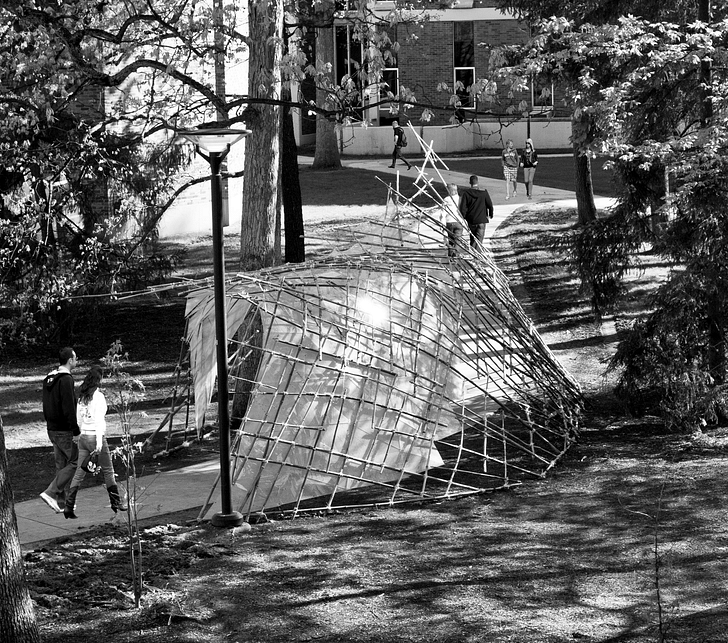
Slipstream is compelling pavilion whose form emerged from an exploration of both spatial phenomena and digital design methodologies. A Slipstream, in essence, is a type of turbulence generated by a body moving rapidly within a larger body. As stated by Lebbeus Woods, “The slipstream is a highly dynamic space active with forces that impel a direction and that itself moves, together with the moving body continuously creating it...” This became the design intention: to express such a phenomenon experientially, to explore the implications of slipstreaming as a spatial construct.
The design itself was conceived as a parametric structure, one that was to be determined and defined by relations. Parametric computation provided a great amount of control, while at the same time, maintained a high level of freedom. Parametric’s permitted us as designers the ability to make modifications at any given point in the process. This allowed for the altering of multiple components and directly manipulating the relationships controlling the overall structure of the design.
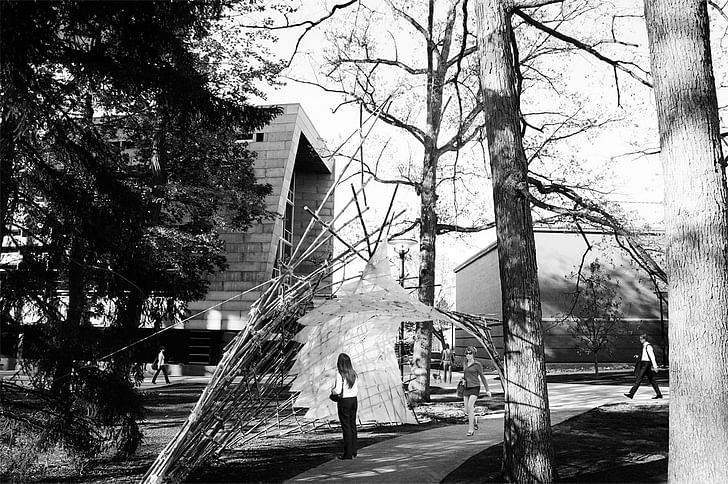
Initially, the idea of slipstreaming was explored 2-Dimensionally. A plane was defined and populated by a network of points. This plane evolved into a surface, which was ultimately subdivided on the basis of a desired number of u/v values. These values, or points, were further used to create a field of vectors. When applied to a surface, the vectors became spatial, and conveyed certain directionality. This directionality gave each vector character, whose genealogy could be traced to its location in relation to a specific attractor point. Such attractors, had an influence on the both the length and direction of each vector, making their location vital to the outcome of the slipstream.
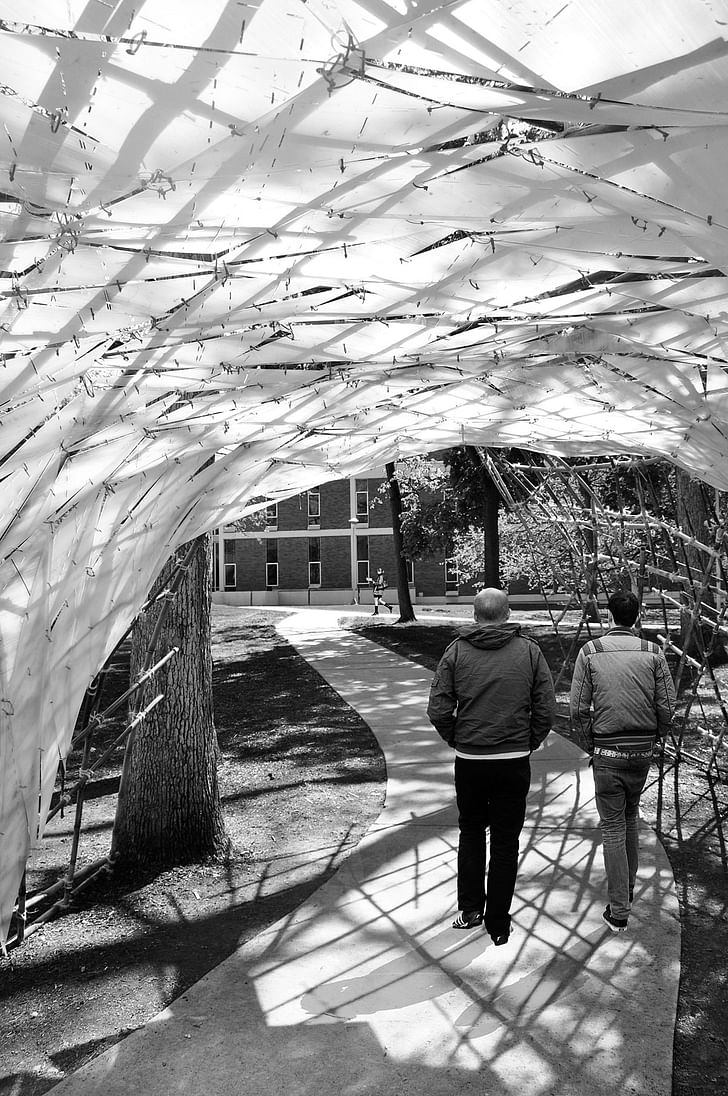
Once the vectors were created, they were projected onto the desired surface, creating unique spatial conditions. These conditions were variable, given the fact that at any given moment, one parameter could change, altering the overall expression of the design. Therefore, the design process developed iteratively. Each iteration of the slipstream became informative of the next. Various iterations produced novelty in structure, while others in aesthetics. It became a constant search, or selection, of what parameters portrayed the slipstream most successfully. Once the desired clarity was established, a subsurface was determined, which was ultimately penetrated by the lines of the slipstream.
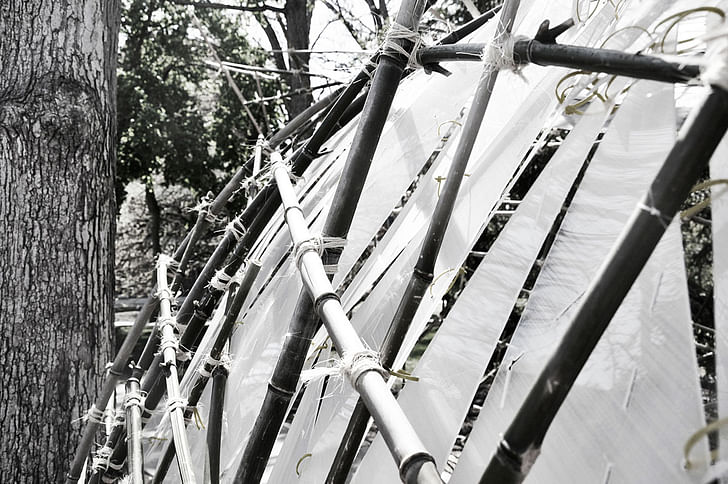
Materiality became an important issue in the design. To achieve the bent, flowing nature of the slipstream’s individual components we explored the flexibility and strength of bamboo stalks. We discovered very quickly an indeterminacy between the forms created computationally and the tolerances of the given materials. By referencing the output from our script all of the intersections were located and bound together. The structure inherently took the imagined geometry once lifted into place due to the fixed lengths of the profiles and their ability to conform to the manipulated geometry. The subsurface was then rendered in a reflective Lexan skin directionally sanded to guide the movement through the space. The lexan allows for a clouding of the periphery when inside the structure and a imaginative reflection when experienced from outside.
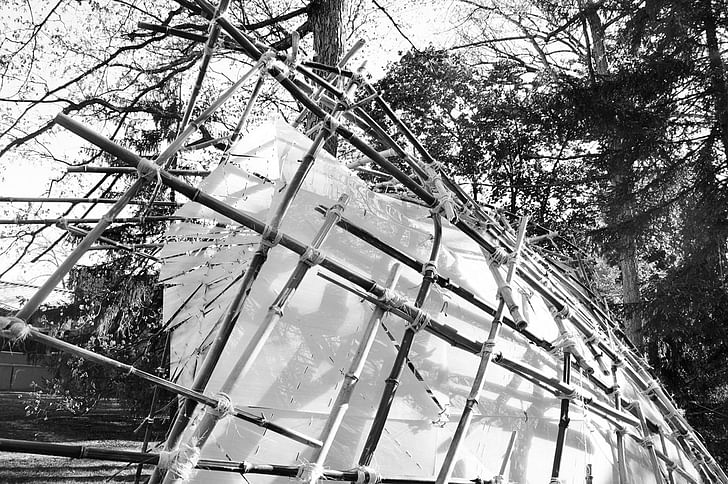
Slipstream began as a search for a new spatial typology. It explored emerging techniques of design and questioned the conditional forms of space. Although its experiences may have been ephemeral, the ideas behind the process are concrete.

Project Details:
Project: Slipstream Pavilion, State College Pa, USA, May 2011
Penn State DigiFAB
Instructor: David Celento
Lead Designers: David A. Palmieri & Kyle M. Schillaci
Project Team: Dan Boghean, Kate Kreisher, Eric Kaing , Tim Vassallo , Colette Aboussouan, Tim Annin , Luong Fletcher, Berrin Terim, Nathaniel Peters, Erica van Rabenswaay
Many thanks to Jamie Heilman, Allen Sutley, Steve White, and Dave Will

1 Comment
turbulence and slipstream describe fluid processes; or at the very least dynamic, shifting relations. this project completely sidesteps these aspirations, instead settling for surface applique... why not a design that restructures pedestrian flows, challenging normative trajectories? or has a spatial dimension beyond curling a surface? as it is, the only (and unfulfilled) potentiality is shadowplay -- the layering and shifting of shadows cast on an undulating surface, provoking one's spatial-temporal notions of atmosphere and enclosure.
this is absolutely valid as a parametric exercise -- but the veneer of sexy words and concepts is pathetic, irritating, and decays in the turbulent slipstream of pseudo-academic diarrhea.
Block this user
Are you sure you want to block this user and hide all related comments throughout the site?
Archinect
This is your first comment on Archinect. Your comment will be visible once approved.